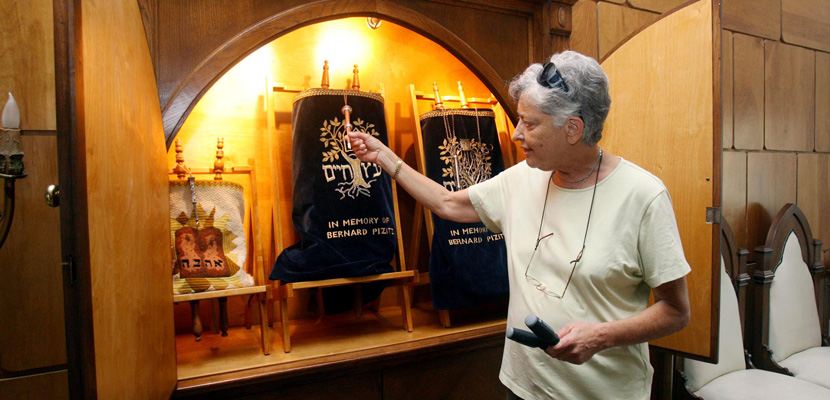We thank Daniel Smokler, Jonathan Sarna, Riv-Ellen Prell, and Chip Edelsberg and Jason Edelstein for their responses to our essay, “The Pew Survey Reanalyzed,” and for the opportunity they have given us to sharpen and clarify our argument.
Before turning to narrower questions, we’ll address the charge that our essay was needlessly alarmist or even misleading in its claims. Jonathan Sarna portrays it as a “prophecy of gloom,” while Chip Edelsberg and Jason Edelstein contend that we’ve “artificially constructed” a cliff that American Jewry is about to fall off of.
We offer no apology for our alarm. With 72 percent of non-Orthodox Jews marrying non-Jews, a birthrate of 1.7 children among the non-Orthodox population, over two million adult offspring of Jews who no longer identify themselves as Jewish, and 93 percent of the grandchildren of the intermarried being raised outside the Jewish religion, we are mystified by reassurances that all is well. We ask our critics: are there any data capable of persuading you that something is seriously amiss with the “Jewish Middle”: that is, the population of active American Jews outside of Orthodoxy?
Some of the criticism by our respondents, and by others offline, seems to arise from annoyance less with what we said than with our saying it at all. Indeed, to many in the organized community, calling attention to serious weaknesses in Jewish life is bad manners, or worse: a turn-off to donors and activists, and hurtful to younger people who might feel themselves blamed for contributing to the problems of the Jewish people. Others admonish us that expressions of worry will simply be tuned out, and that only an upbeat message has a chance of being heard, let alone acted on. By this logic, it would be hard to explain how alarm about, say, climate change has mobilized the energies of so many Jews, and especially younger Jews. Could it be that an alarmist approach to the longstanding evidence of serious decline in American Jewish life might finally elicit the concern it merits?
We are also reminded by our critics that the Jews have been called an “ever dying” people—yet one that somehow always recovers. We do not, however, argue that the Jewish people, or even the American Jewish community, is dying. Our claim is far more limited. Even as pockets of non-Orthodox Jewry remain vibrant and strongly connected, millions of formerly active families are disengaging. Such widespread erosion within this large sector of the once-engaged has enormous implications for the future vitality of American Jewish life as a whole.
History, we are likewise told, is replete with prior warnings of decline that have been proved wrong. True enough: but why were they proved wrong? Because visionary leaders, instead of comfortably trusting in the inevitability of renewal, took concerted action.
We think of Marshall Sklare, the preeminent sociologist of American Judaism in the 1950s and 60s, who predicted the demise of Orthodoxy. What Sklare failed to notice was the heroic efforts being made to rebuild Orthodoxy through intensive Jewish education, the construction of tightly embracing communities, and the frank assumption of a critical posture toward certain aspects of American culture. To transmit their countercultural message, the Orthodox built day schools, summer camps, youth movements, Israel-based programs, and adult-education programs across the length and breadth of the land. Their proactive efforts turned the tide. A similarly bold initiative, we contend, is now needed if the same is to be done for non-Orthodox and non-denominational Jews.
Did we, as we are chided, fail to note all the existing efforts to spur renewal in the American Jewish community? We’re perfectly cognizant of these many initiatives, and each of us has written extensively about them over the past decade. They are to be lauded. Our essay, however, focused on the forest that is American Jewish life, not on the individual trees that are flourishing within it. Looking at non-Orthodox Jews in the aggregate, we asked: what is the big picture that emerges from the Pew data? The answer: it is a picture of severe decline. We then asked: within this picture, which sectors exhibit higher levels of Jewish connection and better demographic prospects? And then we offered specific directions for renewal: building social networks, delivering content-based Jewish meaning, and attending to people’s human needs at different stages of life.
Now to some of the specific items raised by our respondents.
Daniel Smokler is correct: campus Hillels are well-positioned to engage young Jews at a time when, and in a place where, a large majority of them can be reached. In this connection, however, we take exception to his slighting judgment of Chabad. From what we know, Chabad touches a significant segment of non-Orthodox Jewish students who likely will not choose to live an Orthodox life but are inspired by Chabad to deepen their Jewish connections. The same can be said for Birthright Israel, a truly remarkable effort to reach college-age and slightly older Jews that was launched in the aftermath of the 1990 National Jewish Population Study. Where is the parallel initiative in response to the Pew study?
Chip Edelsberg and Jason Edelstein are similarly right to draw attention to existing platforms, both conventional and innovative, in the area of Jewish education. We are appalled, though, that only a handful of Jewish foundations other than their own have joined the effort to expand opportunities for the large majority of young Jews who are not involved in teen, campus, or post-college Jewish activities.
Take youth groups: Edelsberg and Edelstein correctly point to BBYO as a success story. To it, we would add NCSY, the arm of the Orthodox Union. But these are the only two nationwide youth groups that have benefited from major philanthropic investment. Today, such once-flourishing groups, now starved of resources, attract well under a fifth of Jewish teens. Imagine how different things would look if USY, NFTY, Young Judaea, Habonim, Bnei Akiva, and others could obtain substantial backing.
Or take overnight camps: despite the generous support of some major foundations, residential summer camps offer few opportunities for families with limited resources. Another $20 million would make it possible to create spaces for an additional 10,000 campers annually.
Or take teen travel to Israel: while one hundred or so teens from the North Shore of Boston participate annually in fully subsidized educational trips to Israel, courtesy of the Robert I. Lappin Foundation, few other such opportunities exist elsewhere. One result is that most Jewish undergraduates, arriving on campuses rife with anti-Israel agitation, have never encountered Israel first-hand.
In short: thanks to the largesse of Jewish philanthropic foundations, much has been done; but if the majority of young Jews are to be engaged in immersive Jewish activities, much more needs to be done.
Jonathan Sarna evidently accepts our analysis of recent and current trends in Jewish life. As an astute observer of history, however, he cautions us to avoid straight-line projections into the future—and in doing so he situates the challenges facing American Judaism within the context of American religion in general. Thus, in a pattern analogous to what we have described in the non-Orthodox sectors, mainline American Protestantism has suffered for decades from the emptying of its pews. American Catholicism is also witnessing a decline in the number of churchgoers as well as a dearth of clergy and the shuttering or merging of parishes.
Religion, indeed, is in recession in this country, as Sarna correctly notes, and in Europe it is deep into a decades-long depression. But what is to be learned from this? We half-expected Sarna to offer solace along the lines of “misery loves company.” Instead, referring to past cycles in America of religious decline followed by renewal, he presents the vision of a Great Awakening in the offing.
Although we are not so sanguine on that score, Sarna has touched on something with crucial policy implications for American Jews. “As go the Christians, so go the Jews,” Heinrich Heine quipped, and there is a strong element of truth in that aperçu. If Jewish religious life is indeed to revive, it might well be spurred by a comeback of American religion in general. Would it not then behoove Jewish organizations to help restore religious life in this country? Any effort in that direction, however, would require a very different approach to public policy from the one followed by the organized Jewish community over the past half-century.
In her own trenchant analysis, Riv-Ellen Prell broadens the discussion beyond religion to an examination of today’s dominant cultural assumptions. Nothing less is on the American horizon, she concludes, than the collapse and ruin “of an Enlightenment worldview that was essential to the very Judaism that is slipping away.” As we read her, all the fine programs we can add to the mix will not make much of a dent until we confront the shifts in underlying values and outlook that have eroded the solidarity of Jews and their commitment to a larger Jewish collective.
Of particular concern to Prell, as to us, are recent patterns of diminished marriage and childbearing in America—testimony, in her words, to the fact that “younger Americans do not value marriage” in the same way that earlier generations did. We salute her: in today’s climate, even to note such tectonic shifts requires courage. American Jewish leaders would be well advised to ponder the implications of the “radical cultural change” and disturbing demographic trends she has identified and their impact on Jewish solidarity and Jewish numbers.
Which brings us back to Edelsberg and Edelstein, who, even as they appear to endorse many of the policy directions we propose, express sharp criticism of the analysis leading up to them. Particularly offensive to them is our quotation of Milton Himmelfarb’s comment about the long-term impact of intermarriage on Jewish identity. We wrote:
[I]t is exceedingly difficult to raise children committed to Jewish life in families with two separate religions. Decades ago, Milton Himmelfarb made the point succinctly when he was asked what the grandchild of an intermarried Jew should be called. “A Christian,” he answered.
Himmelfarb was simply making a prediction. He was not preemptively reading anybody out of the Jewish community; nor do we advocate such a thing. But we cannot ignore the fact that the vast majority are writing themselves out. We know this because the Pew data, unlike earlier surveys, make it possible to identify both the Jewish and the non-Jewish adult offspring of intermarried parents. Of those adults under the age of fifty who grew up in exogamous families and are now parents themselves, just 7 percent—one in fourteen!—are raising their children in the Jewish religion. No matter how one may yearn to think of all these grandchildren of the intermarried as Jewish, both they and their parents have other ideas in mind.
In the end, just as our critics have challenged us, we challenge them in turn. Where is the evidence that placing a positive spin on the Pew data will spur communal action rather than inertia? If Jonathan Sarna is correct, and American Jewry’s “best years may still lie ahead,” where are the signs that the organized community has the will to address its internal problems and marshal the necessary resources to engage in serious rebuilding?
We must find ways to bend the trend lines. A good place to begin is with hard-headed reflection on where the American Jewish community is going and which investments are urgently called for at this critical—and transitory—inflection point in its history.
More about: American Jewry, Jewish continuity, Pew Survey







